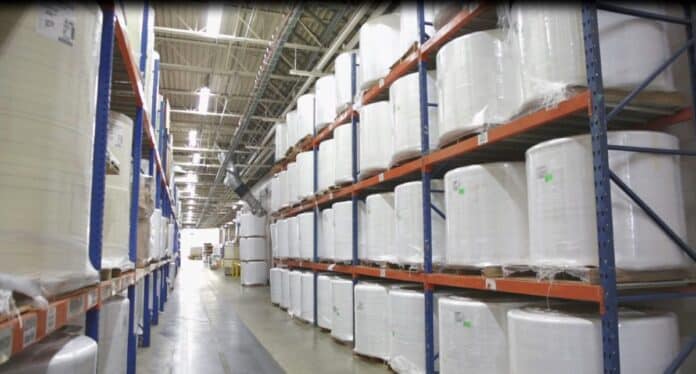
Cummins Inc. has teamed up with DuPont to repurpose engine-filtration material to help supply N95 respirator masks for health care professionals on the frontlines of the COVID-19 pandemic.
The material, which is typically used for air, fuel and lube filtration products to prevent long-term wear in diesel engines, has been successfully tailored to be a suitable alternative to filtering material currently used to make N95 masks, said Greg Hoverson, executive director of engineering at Cummins Filtration, who is involved in the effort.
Cummins officials believe the Columbus-based company has the capacity to produce enough material for mask manufacturers to make “several million masks per month,” with the bulk of material initially coming from a Cummins facility in South Korea, Hoverson said.
So far, Cummins has produced enough material to be converted into several hundred thousand masks, and an estimated tens of thousands of masks with Cummins material have already been made as several potential manufacturers review how the material, also called media, will work with their production equipment and manufacturing processes.
[sc:text-divider text-divider-title=”Story continues below gallery” ]
“We’re really in a position right now where multiple different mask makers have our media and are evaluating and are converting samples into actual masks at different points of submission for certification,” Hoverson said.
Currently, governors and hospital officials around the country are warning of a dire shortage of masks and other personal protective equipment for health care workers treating infected patients, and mask makers are struggling to keep up with surging demand, The Associated Press reported.
A shortage of masks could place health care workers at a higher risk of catching COVID-19 and reduce the number of staff available to treat patients.
In a “best-case scenario,” health care workers in Indiana, for instance, go through around 50,000 masks per day even when taking measures to conserve supply, said Indiana State Health Commissioner Dr. Kris Box. That would place the need for the masks at around 1.5 million masks per month.
Masks that receive the “N95” designation can block at least 95% of airborne particles from entering a person’s nose or mouth, providing more protection against the virus that causes COVID-19 than ordinary surgical masks, according to the U.S. Food and Drug Administration.
COVID-19 is mainly spread between people who are in close contact with each other through respiratory droplets produced when an infected person coughs or sneezes, according to the federal Centers for Disease Control. It is also believed that a person can get COVID-19 by touching a surface or object that has the virus on it and then touching their mouth, nose or eyes.
Hoverson said Cummins started exploring the possibility of repurposing the filtering material in February to help with a shortage of material needed to make them.
The specific technology that is being used to make the filtering material includes Cummins’ NanoNet and NanoForce Media technology, which uses DuPont’s Hybrid Membrane Technology, Cummins said.
In March, an interdisciplinary research team at the University of Minnesota, including the Center for Filtration Research Consortium, assembled the first mask prototypes using Cummins’ material in an effort to provide masks to Minneapolis-based healthcare systems, the company said.
The researchers designed two respirator mask prototypes from donated filter material by Cummins — one modified anesthesia mask and one single-use, disposable mask, the university said.
“The first thing we recognized from our experts in the Center for Filtration Research, who work directly with Cummins, is that not all filtration materials are created equal and that the Cummins material is an excellent alternative,” said Jakub Tolar, campus health officer and medical school dean at the University of Minnesota. “We are tremendously grateful for the generous donation from Cummins of their filtration materials toward our mask effort. Since the arrival of the filtration media, we have been able to make rapid progress, and we now believe we have several viable mask options, including both a disposable and re-usable option. These designs show real promise in keeping our health care workers safe should standard medical supplies of N95 masks no longer be available.”
Hoverson said it has been rewarding to potentially help healthcare workers and others during the pandemic.
“It is pretty rewarding to feel that we might be able to contribute something that is of need in this time crisis,” Hoverson said. “What I found in all of this, I see all these stories of people who want to help and are willing to help, and I think all of us are probably similar in that vein. But having an opportunity to actually deliver on that is pretty rewarding.”
[sc:pullout-title pullout-title=”Where to learn more” ][sc:pullout-text-begin]
Visit cumminsfiltration.com/respiratormedia for more information about the filtration material.
[sc:pullout-text-end][sc:pullout-title pullout-title=”For more information” ][sc:pullout-text-begin]
To learn more about Cummins, visit cummins.com/
[sc:pullout-text-end]




